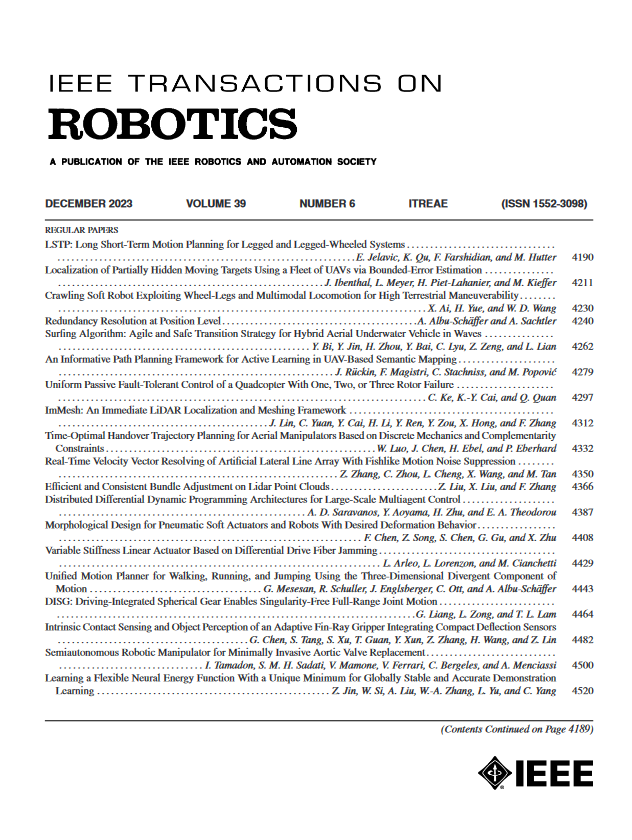利用隐式行为克隆和动态运动原型促进机器人运动规划的强化学习
IF 9.4
1区 计算机科学
Q1 ROBOTICS
引用次数: 0
摘要
用于多自由度机器人运动规划的强化学习(RL)仍然存在训练速度慢、泛化能力差等低效问题。在本文中,我们提出了一种新颖的基于强化学习的机器人运动规划框架,利用隐式行为克隆(IBC)和动态运动基元(DMP)来提高非策略强化学习代理的训练速度和泛化能力。IBC 利用人类演示数据来提高 RL 的训练速度,而 DMP 则充当启发式模型,将运动规划转移到更简单的规划空间中。为此,我们还利用拾放实验创建了人类演示数据集,可用于类似研究。对比研究表明,与传统的 RL 代理相比,所提出的方法具有训练速度更快、得分更高的优势。真实机器人实验表明,建议的方法适用于简单的装配任务。我们的工作提供了一个新的视角,即利用运动基元和人类示范来为机器人应用发挥 RL 的性能。本文章由计算机程序翻译,如有差异,请以英文原文为准。
Using Implicit Behavior Cloning and Dynamic Movement Primitive to Facilitate Reinforcement Learning for Robot Motion Planning
Reinforcement learning (RL) for motion planning of multi-degree-of-freedom robots still suffers from low efficiency in terms of slow training speed and poor generalizability. In this article, we propose a novel RL-based robot motion planning framework that uses implicit behavior cloning (IBC) and dynamic movement primitive (DMP) to improve the training speed and generalizability of an off-policy RL agent. IBC utilizes human demonstration data to leverage the training speed of RL, and DMP serves as a heuristic model that transfers motion planning into a simpler planning space. To support this, we also create a human demonstration dataset using a pick-and-place experiment that can be used for similar studies. Comparison studies reveal the advantage of the proposed method over the conventional RL agents with faster training speed and higher scores. A real-robot experiment indicates the applicability of the proposed method to a simple assembly task. Our work provides a novel perspective on using motion primitives and human demonstration to leverage the performance of RL for robot applications.
求助全文
通过发布文献求助,成功后即可免费获取论文全文。
去求助
来源期刊

IEEE Transactions on Robotics
工程技术-机器人学
CiteScore
14.90
自引率
5.10%
发文量
259
审稿时长
6.0 months
期刊介绍:
The IEEE Transactions on Robotics (T-RO) is dedicated to publishing fundamental papers covering all facets of robotics, drawing on interdisciplinary approaches from computer science, control systems, electrical engineering, mathematics, mechanical engineering, and beyond. From industrial applications to service and personal assistants, surgical operations to space, underwater, and remote exploration, robots and intelligent machines play pivotal roles across various domains, including entertainment, safety, search and rescue, military applications, agriculture, and intelligent vehicles.
Special emphasis is placed on intelligent machines and systems designed for unstructured environments, where a significant portion of the environment remains unknown and beyond direct sensing or control.
 求助内容:
求助内容: 应助结果提醒方式:
应助结果提醒方式:


